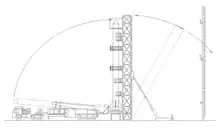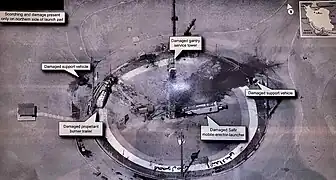 Safir's 2012 launch from Semnan Space Center with Navid satellite as its payload | |
| Function | LEO launch vehicle |
|---|---|
| Manufacturer | Iranian Space Agency |
| Country of origin | Iran |
| Size | |
| Height | 22 m (72ft) |
| Diameter | 1.25 m (4.10ft) |
| Mass | 26,000 kg |
| Stages | 2 |
| Capacity | |
| Payload to LEO | |
| Mass | 50 kilograms (110 lb) |
| Launch history | |
| Status | Retired |
| Launch sites | Semnan Space Center |
| Total launches | 7 (1 unconfirmed) (+2 test flights) |
| Success(es) | 4 |
| Failure(s) | 3 (1 unconfirmed) |
| First flight | 17 August 2008 |
| Last flight | 5 February 2019 |
| First stage | |
| Powered by | 1 × modified Shahab-3 engine |
| Maximum thrust | 363 kN (82,000 lbf) |
| Propellant | N2O4 / UDMH |
| Second stage | |
| Powered by | 2 × R-27 Zyb vernier engines |
| Maximum thrust | 35 kN (7,900 lbf) |
| Propellant | N2O4 / UDMH |
The Safir (Persian: سفیر, meaning "ambassador") was the first Iranian expendable launch vehicle able to place a satellite in orbit.[1] The first successful orbital launch using the Safir launch system took place on 2 February 2009 when a Safir carrier rocket placed the Omid satellite into an orbit with a 245.2 km (152.4 mi) apogee.[2][3] This made Iran the ninth nation capable of producing and launching a satellite.[4]
The Simorgh is a larger orbital launcher based on Safir technology which has since replaced the Safir, and is sometimes called the Safir-2.[5]
Design and specifications
The Safir measures 1.25 meters in diameter, 22 meters in height and has a launching mass of 26 tons. The rocket consists of two stages; The first stage utilizes an upgraded Nodong/Shahab-3 type engine which burns a hypergolic combination of UDMH as fuel and nitrogen tetroxide as oxidant, producing 37 tons (363 kN; 82,500 lbf) of thrust. The second stage utilizes a pair of smaller engines (originally the Vernier engines of the R-27 Zyb Soviet SLBM[6]) burning the same fuel combination as the first stage and producing 3.5 tons (35 kN; 7700 lbf) of thrust. This configuration gives Safir the ability to inject a payload with a maximum weight of 50 kilograms into low Earth orbit.[7]

Variants
Kavoshgar-1
Kavoshgar-1 (Persian: کاوشگر ۱, "Explorer-1") was Safir's precursor used as a sounding rocket, a sub-orbital flight was conducted on 4 February 2008, as announced by state-run television. A launch on 25 February 2007 may also have been of the same type. The flight carried instruments to measure the higher atmosphere. The rocket launched on 4 February 2008 was a liquid-propellant-driven rocket, a derivative of the Shahab-3, that reached an altitude of 200–250 km in space, and successfully returned science data according to the Iranian News Agency.[8][9]
On 19 February 2008, Iran offered new information about the rocket and announced that Kavoshgar-1 used a two staged rocket. The first stage separated after 100 seconds and returned to earth with the help of a parachute. The second stage continued its ascent to an altitude of 200 kilometers.[10]
Safir-1A
The Safir-1A is the first upgraded variant of the original Safir, these upgrades include, refinement of the second stage retro-rockets, stage separation systems, various sensors and telemetry systems, navigation and control systems, as well as increasing maximum orbit height from 250 to 275 kilometers.[11][12]
Safir-1B
The Safir-1B is a further upgrade of the Safir-1A design, the first-stage engine has been upgraded and refined, resulting in an increase in thrust from 32 to 37tons (363 kN; 82,500 lbf), the second stage engine has been upgraded with thrust vector control capability and has been made more efficient. These upgrades have increased payload capability to 50 kilograms, and have increased maximum orbit height to 400 kilometers.[7][12]
Retirement
During the unveiling ceremony of the Zuljanah satellite launch vehicle on the state TV, Seyed Ahmad Husseini, the spokesman of the Ministry of Defense's Aerospace Organization stated that the Safir Launch vehicle is in a state of retirement and no further launches are planned with this vehicle.[13][14][15]
Launch history
Safir has made eight launches so far, putting four satellites into orbit.
| Test flights | |||||||
|---|---|---|---|---|---|---|---|
| Flight no. | Date & time
(UTC) |
Payload | Rocket configuration | Outcome | |||
| 1 | 4 February 2008 | Unknown | Kavoshgar-1 | Successful suborbital test flight of Safir's precursor.[8][9] | |||
| 2 | 17 August 2008 | Unknown; may be boilerplate | Safir-1 | Iranian officials claimed that the launch was a successful suborbital test carrying a boilerplate satellite. US defense officials claimed the vehicle failed after first-stage powered flight.[16][17] | |||
| Operational flights | |||||||
| Flight no. | Date & time
(UTC) |
Payload | Rocket configuration | Outcome | Achieved orbit | Remarks | |
| 1 | 2 February 2009 | 27 kg | Safir-1 | Success | 381.2 x 245.5 km, i 55.71° | First successful orbital launch of Safir making Iran the ninth country to develop an indigenous satellite launch capability.[18] | |
| 2 | 15 June 2011 | 15.3 kg | Safir-1A | Success | 271 x 233 km, i 55.6° | Rasad-1 was launched on the maiden flight of the Safir-1A | |
| 3 | 3 February 2012 | 50 kg | Safir-1B | Success | 375 x 250 km, i 55° | New configuration of the Safir carrier rocket, featuring a larger second stage with 20% more thrust.[19] | |
| ? | Between 18 May and 21 June 2012 | ? | ? | ? | Supposed failure | Satellite imagery shows a blast scar on launch pad, suggesting that there has been a launch. No officials have confirmed a launch. It may have been either an engine test or rocket failure at high altitude.[5] | |
| 5 | 2 February 2015 | 52 kg | Safir-1B | Success | 470 x 224 km, i 55.57° | First Iranian satellite with orbital maneuverability using cold-gas thrusters. | |
| 6 | 5 February 2019 | 52 kg | Safir-1B | Failure | The Deputy Minister of Defense in Iran claimed a successful launch.[20] Research associates at the Middlebury Institute of International Studies claimed the launch failed at some point after liftoff.[21] | ||
| (7) | 29 August 2019 | No payload[22] | Safir-1B | Failure | Launch preparation accident.[23][24] | ||

Gallery
 2012 launch of navid satellite
2012 launch of navid satellite Safir at an exhibition at the Mosalla of Tehran
Safir at an exhibition at the Mosalla of Tehran Safir first-stage engine
Safir first-stage engine
See also
Other Iranian satellite launch vehicles
References
- ↑ Parisa Hafezi (2008-08-17). "Iran launches first home-made satellite into space". Reuters. Retrieved 2008-08-17.
- ↑ "OMID Spacecraft - Trajectory Details". NASA NSSDC.
- ↑ "The Threat". US Missile Defense Agency. Archived from the original on 2009-11-05.
- ↑ Clark, Stephen (2 February 2009). "Iran Launches Omid Satellite Into Orbit". Space.com. Retrieved 2021-04-05.
- 1 2 Clark, Stephen (11 February 2019). "Second Iranian satellite launch attempt in a month fails". Spaceflight Now. Retrieved 12 February 2019.
- ↑ "Soviet R-27 SLBM and the reuse of its steering engines by North Korea and Iran". www.b14643.de. Retrieved 2021-04-05.
- 1 2 "Safir-1A/B IRILV". www.b14643.de. Retrieved 2021-04-05.
- 1 2 ایران, پایگاه اطلاع رسانی شبکه خبر صدا و سیمای جمهوری اسلامی (2015-04-06). "نگاهی به توانمندی ایران در بخش موشک های ماهواره بر و نظامی" (in Persian). Islamic Republic of Iran News Network. Retrieved 2021-04-05.
- 1 2 "Iran's Research Rocket Beams Back Science Data". Space.com. Associated Press. 2008. Retrieved 2009-01-11.
- ↑ Yiftah Shapir (March 5, 2008). "The Launch of the Iranian Kavoshgar Rocket". The Institute for National Security Studies. Retrieved March 19, 2023.
- ↑ ""ذوالجناح" عضو جدید اسکادران ماهوارهبرهای ایرانی شد". ایسنا (in Persian). 2021-02-01. Retrieved 2021-04-05.
- 1 2 "خانواده ماهوارهبرهای 'سفیر' را بهتر بشناسید". مشرق نیوز (in Persian). 2013-08-18. Retrieved 2021-04-05.
- ↑ "نگاهی به ماهواره برهای ایرانی (سفیر و سیمرغ )". گروه آموزشی زانکو (in Persian). 2020-01-29. Retrieved 2021-04-05.
- ↑ ""سفیر" رسما بازنشسته شد تا "سیمرغ" مهیای سفر فضایی شود/ طلسم استفاده ماهوارهبر ایرانی از سوخت جامد با سریر و سروش میشکند؟ +عکس". مشرق نیوز (in Persian). 2020-01-28. Retrieved 2021-04-05.
- ↑ "سخنگوی گروه فضایی وزارت دفاع: ماهوارهبرهای "سریر" و "سروش" رونمایی میشوند/ به دنبال ماهوارهبر سوخت جامد هستیم- اخبار نظامی | دف - اخبار سیاسی تسنیم | Tasnim". خبرگزاری تسنیم | Tasnim (in Persian). Retrieved 2021-04-05.
- ↑ "Iran launches satellite carrier". BBC News. 2008-08-17. Retrieved 2008-08-17.
- ↑ "Safir Data Sheet". Space Launch Report. 6 February 2018. Retrieved 19 March 2018.
- ↑ McDowell, Jonathan. "Issue 606". Jonathan's Space Report. Retrieved 2009-02-03.
- ↑ "ماهواره ملي"نويد علم و صنعت"بهفضا پرتاب شد". Archived from the original on 2015-12-22. Retrieved 2012-02-03.
- ↑ "Иран запустил второй за месяц спутник собственного производства". РИА Новости (in Russian). 2019-02-07. Retrieved 2019-02-07.
- ↑ Brumfiel, Geoff (2019-02-06). "Satellite Imagery Suggests 2nd Iranian Space Launch Has Failed". NPR.org. Retrieved 2019-02-07.
- ↑ "Mysterious Iran rocket blast draws Trump tweet, Tehran taunt". AP NEWS. 2021-04-20. Retrieved 2022-06-24.
- ↑ Iranian Rocket Launch Ends In Failure, Imagery Shows npr.org
- ↑ Iran rocket launch failure satellite photo space.com
External links
- Iran's Research Rocket Beams Back Science Data, Space.com
- Iran Launches Rocket, Unveils Space Center, Space.com
- Iran's Sputnik, SpaceRef.com
- Iran rocket claim raises tension, BBC
- Iran: Rocket Launch Another Show Of Prowess, RadioFreeEurope RadioLiberty
- Iran claims space rocket launch, AlJazeera
- Iranians inaugurate space project, BBC
- Iran to Launch 2 More Research Rockets Before Placing Satellite into Orbit This Summer, on Space.com
- Iran Launches Indigenous Carrier Rocket